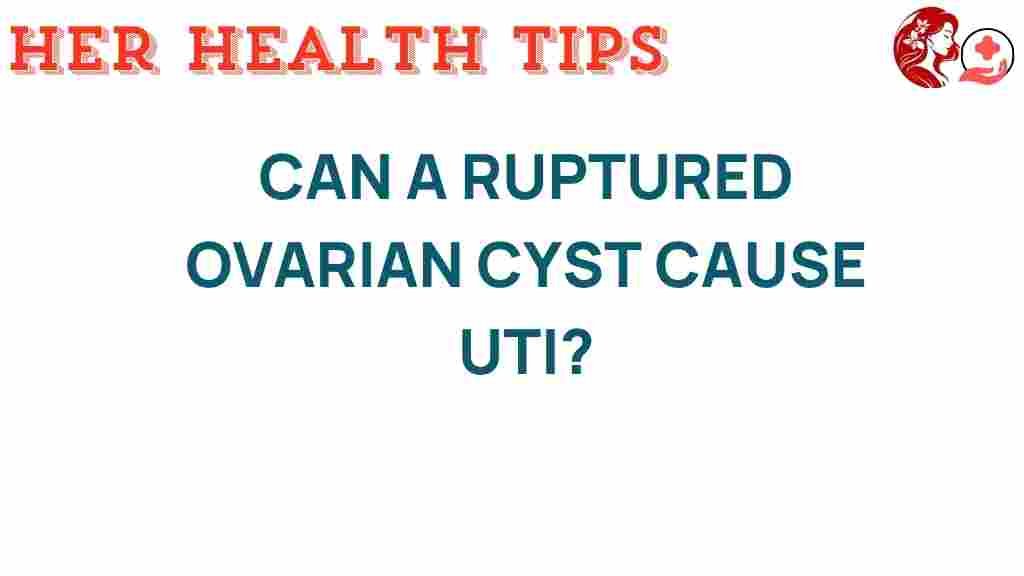The Surprising Link Between Ruptured Ovarian Cysts and UTIs
Women’s health encompasses a wide array of topics, and two conditions that often go unrecognized in their interconnectedness are ruptured ovarian cysts and urinary tract infections (UTIs). Understanding how these conditions relate can help women make informed decisions about their health. In this article, we will explore the symptoms, diagnosis, and treatment of both ruptured ovarian cysts and UTIs, as well as provide insights into pelvic pain and its implications for women’s health.
Understanding Ruptured Ovarian Cysts
A ruptured ovarian cyst occurs when a fluid-filled sac on the ovary breaks open. This can happen during the menstrual cycle or due to physical activities. While many women may experience ovarian cysts without any symptoms, a rupture can lead to significant discomfort and complications.
Symptoms of a Ruptured Ovarian Cyst
Recognizing the symptoms of a ruptured ovarian cyst is crucial for timely diagnosis and treatment. Common symptoms include:
- Sudden, severe pelvic pain
- Bloating
- Nausea or vomiting
- Difficulty in breathing
- Heavy menstrual bleeding
- Urinary urgency or frequency
If you experience severe pelvic pain, it’s essential to seek medical attention immediately, as this could indicate a more serious condition.
How Ruptured Ovarian Cysts Can Influence UTIs
Many women may not realize that there is a connection between ruptured ovarian cysts and UTIs. The pelvic region is a complex network of organs, and disturbances in one area can affect others. When an ovarian cyst ruptures, the resulting inflammation can irritate nearby structures, including the bladder and urethra.
The inflammation caused by a ruptured cyst may lead to:
- Increased susceptibility to infections, such as UTIs
- Discomfort during urination
- Exacerbation of existing urinary symptoms
Diagnosing Ruptured Ovarian Cysts and UTIs
Getting an accurate diagnosis is vital for effective treatment. If you experience symptoms indicating a ruptured ovarian cyst or UTI, here’s how the diagnosis process typically unfolds:
Step 1: Medical History and Symptoms Review
Your healthcare provider will ask about your symptoms, medical history, and any medications you’re taking. Be honest and thorough, as this information is critical for an accurate diagnosis.
Step 2: Physical Examination
A pelvic exam will help the doctor assess any tenderness or abnormalities in the pelvic area. This can provide essential clues about the presence of a ruptured cyst or infection.
Step 3: Imaging Tests
To confirm a ruptured ovarian cyst, your doctor may recommend imaging tests, such as:
- Ultrasound
- CT scan
These tests can help visualize the ovaries and surrounding structures for any abnormalities.
Step 4: Urine Tests
If a UTI is suspected, a urine test will be conducted to check for the presence of bacteria, blood, or other indicators of infection.
Treatment Options for Ruptured Ovarian Cysts and UTIs
Effective treatment is essential to manage the symptoms and prevent complications. Here’s an overview of treatment options for both conditions:
Treatment for Ruptured Ovarian Cysts
Most ruptured ovarian cysts resolve on their own without the need for surgical intervention. However, treatment may include:
- Pain management: Over-the-counter pain relievers like ibuprofen or acetaminophen can help alleviate discomfort.
- Monitoring: Regular follow-up visits to ensure the cyst heals properly.
- Surgery: In severe cases, where excessive bleeding or infection occurs, surgical intervention may be necessary.
Treatment for UTIs
UTIs are typically treated with antibiotics. The specific antibiotic and duration of treatment depend on the severity of the infection:
- Short-term antibiotics: Commonly prescribed for uncomplicated UTIs.
- Long-term antibiotics: May be recommended for recurrent infections.
In addition to antibiotics, women can take steps to prevent future UTIs:
- Stay hydrated and drink plenty of water.
- Urinate after sexual intercourse to flush out bacteria.
- Practice good hygiene, especially during menstruation.
Managing Pelvic Pain
Pelvic pain can be a significant concern for women experiencing either ruptured ovarian cysts or UTIs. Understanding how to manage this pain is crucial for improving quality of life.
Self-Care Strategies
Here are some effective self-care strategies to manage pelvic pain:
- Heat therapy: Applying a heating pad to the pelvic area can help reduce pain and discomfort.
- Gentle exercise: Activities like walking or yoga can improve circulation and relieve tension.
- Relaxation techniques: Practices such as deep breathing, meditation, or gentle stretching can help reduce stress and ease pain.
When to Seek Healthcare
While many cases of ruptured ovarian cysts and UTIs can be managed at home or with outpatient care, certain situations warrant immediate medical attention:
- Severe or worsening pelvic pain
- High fever or chills
- Heavy bleeding or unusual discharge
- Signs of infection, such as persistent urination pain or fever
Always trust your instincts. If something feels off, don’t hesitate to contact your healthcare provider.
Conclusion
The connection between ruptured ovarian cysts and UTIs is surprising yet significant. Understanding the symptoms, diagnosis, and treatment options for both conditions can empower women to take charge of their health. If you experience any concerning symptoms, it’s essential to consult with a healthcare professional for an accurate diagnosis and appropriate treatment.
For more information on women’s health issues, you can visit womenshealth.gov. Stay informed, and take proactive steps to maintain your health!
Additionally, for further reading on urology and related topics, check out this resource.
Remember, your health is your wealth, so prioritize it every day!
This article is in the category Reproductive and created by HerHealthTips Team
